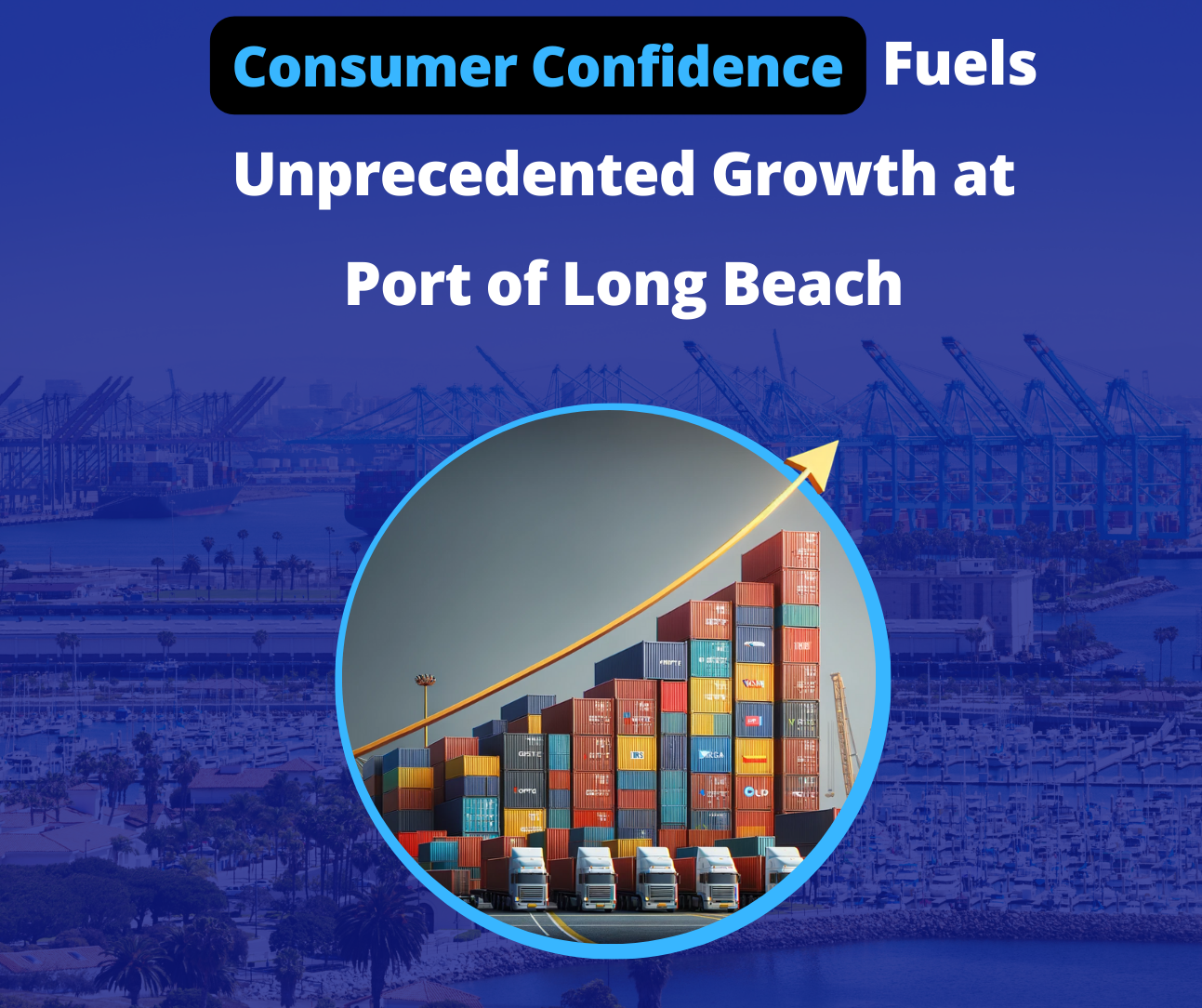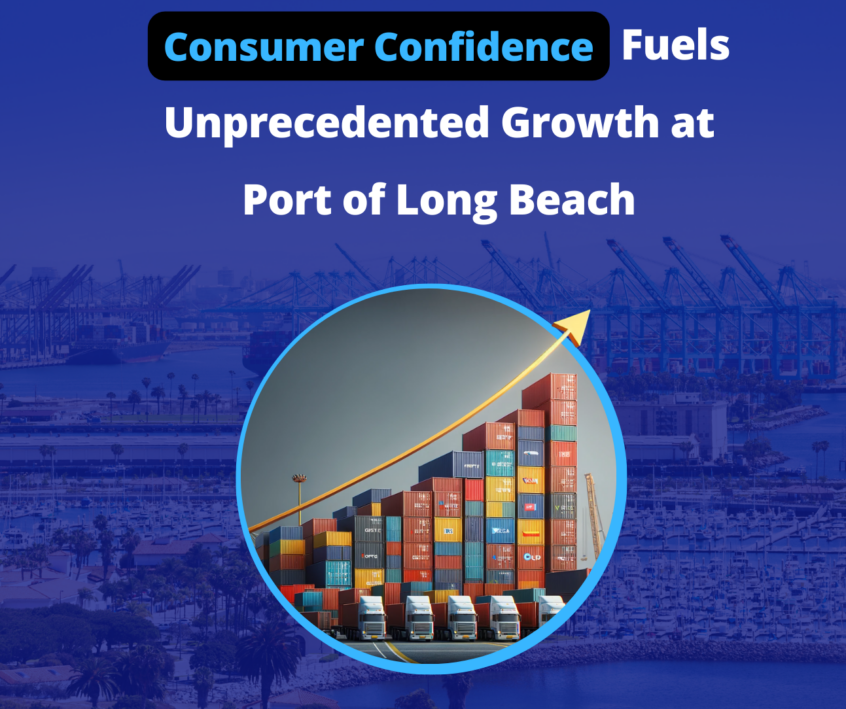
Unprecedented growth for port of Long Beach’s during record September
The logistics and shipping industries are witnessing a remarkable turn of events as the Port of Long Beach, a West Coast gateway. It has recently been reported that Long Beach has broken all records by achieving its busiest September ever. Amidst this unprecedented growth, consumer confidence is on the rise. This is not just a coincidence.
This article delves deep into the implications and far-reaching effects of this astounding achievement, making it clear that the Port of Long Beach’s remarkable performance is more than just a local milestone.
A Historic September at the Port of Long Beach
In logistics and shipping, records are meant to be broken—the star is the Port of Long Beach in Southern California, which has just set a new benchmark. Reporting its busiest September ever, the port moved a staggering 829,429 twenty-foot equivalent units (TEUs) during this month. This number represents an 11.8% increase from the previous year.
A comparative analysis shows that this level even surpasses the record set during the height of the e-commerce boom in September 2020. Even more striking is this September marked the first year-over-year increase in cargo in 14 months.
Behind these impressive figures lies a significant shift in consumer confidence and a vital agreement reshaping the logistics landscape. As we delve into this unprecedented achievement, we will explore its implications on the logistics and shipping industries, the global supply chain, and what it means for businesses and consumers.
Consumer Confidence: A Driving Force
Consumer confidence is an economic sentiment that encapsulates consumers’ optimism about the state of the economy and their own financial stability. It acts as a gauge of consumers’ willingness to spend money on goods and services, playing a profound role in steering economic activity. When consumer confidence rises, it ignites a cascade of positive effects. Here’s how it propels the logistics and shipping industry:
1. Increased Demand: Growing consumer confidence means that people are more inclined to make purchases. Whether it’s everyday goods or holiday-related items, the upsurge in demand drives businesses to restock their inventories and prepare for heightened consumer activity. This surge in demand triggers an influx of goods into the market, prompting companies to utilize the services of ports like the Port of Long Beach.
2. Economic Growth: Elevated consumer spending is synonymous with economic growth. As consumers open their wallets, leading to increased sales and stimulating business operations. With more transactions occurring, the logistics industry faces the challenge of efficiently transporting goods to meet the heightened demand.
3. Supply Chain Resilience: Robust consumer confidence impels businesses to bolster their supply chains. The logistics sector is critical in ensuring that goods can flow smoothly from manufacturers to consumers. The surge in demand compels logistics providers to ensure the efficient, timely, and reliable delivery of products.
4. Port Activity: When consumer confidence is high, it directly translates into increased port activity. Ports are essential conduits through which goods enter and exit the country. As consumers boost their purchases, the Port of Long Beach and similar facilities experience heightened cargo traffic and, consequently, higher shipping volumes.
A Vital Labor Agreement is the Catalyst for Change
While rising consumer confidence creates an environment conducive to increased consumption and imports, a critical factor bolstering the logistics landscape is the agreement between the International Longshore and Warehouse Union (ILWU) and the Pacific Maritime Association (PMA).
The ILWU, representing the interests of dockworkers, and the PMA, representing port employers, reached a tentative labor agreement in June. The ratification of this six-year labor contract on August 31 marked a significant turning point in the logistics and shipping industry. Here’s how this agreement is reshaping the landscape:
1. Labor Stability: Labor disputes and strikes can severely disrupt port operations. The ratification of a labor agreement provides much-needed stability. This, in turn, enhances the predictability of operations at the Port of Long Beach and other West Coast gateways. Businesses can rely on the consistent functioning of ports, which is crucial for supply chain efficiency.
2. Reduced Uncertainty: Labor negotiations often introduce uncertainty into the logistics industry. Shippers and carriers may become apprehensive about the potential impacts of labor disputes on their operations. The ratified labor agreement alleviates this uncertainty, enabling businesses to make more informed and confident decisions regarding their shipping and logistics needs.
3. Positive Industry Image: A stable labor agreement portrays the logistics industry positively. This fosters a more favorable perception of the industry among businesses, investors, and the public. A positive image can lead to increased investments, improved service quality, and the overall growth of the logistics sector.
4. Potential for Growth: With the ratification of a labor agreement, the logistics industry is poised for expansion. The certainty that the agreement brings allows logistics providers and port operators to plan for the future with confidence. This can lead to infrastructure investments and the enhancement of facilities to meet growing demand.
Port of Long Beach’s record-breaking September is more than an isolated achievement. Instead, it reflects broader economic dynamics, with rising consumer confidence acting as a catalyst for increased demand. Additionally, the vital labor agreement ensures stability and predictability in the logistics and shipping industry.
Together, these factors are reshaping the landscape, fostering growth, and positively impacting businesses, supply chains, and consumers alike. The record-breaking September at the Port of Long Beach isn’t just about numbers; it’s a testament to the ever-evolving logistics landscape and the industry’s ability to adapt to changing economic conditions.
Consumer Confidence & the Port’s Success
The record-breaking performance of the Port of Long Beach can be directly attributed to the soaring levels of consumer confidence. To understand this relationship, we must first appreciate consumer confidence in economics. Consumer confidence is an essential economic indicator that reflects the willingness and optimism of consumers to spend money on goods and services. In simpler terms, it measures how good people feel about their financial prospects. When consumer confidence is high, people tend to spend more, which has a profound impact on various industries, including retail, manufacturing, and logistics.
In the case of the Port of Long Beach, this rise in consumer confidence has led to increased demand for goods and products. The port’s record-breaking cargo movement in September is largely attributed to this demand, particularly for holiday-related goods. The import surge, up 19.3% year-over-year to 408,926 TEUs, indicates that consumers are eager to purchase items for the upcoming holiday season. This is a significant shift, considering the logistics industry has been grappling with lower volumes for over a year.
The remarkable rise in consumer confidence, marked by increased spending, suggests that the import drought experienced by the logistics and shipping industry may finally be over. An end to this import drought signifies better prospects for numerous businesses that depend on the shipping of goods.
The Impact on the Logistics & Shipping Industry
The Port of Long Beach’s record September has far-reaching implications for the logistics and shipping industry. These implications are not just local but global in nature, affecting supply chains, businesses, and consumers in multiple ways:
1. Global Supply Chains: The increase in cargo at the Port of Long Beach is a promising sign for global supply chains. As one of the largest and busiest ports in the world, this record performance is indicative of changing dynamics in the movement of goods on a global scale.
2. Businesses and Retailers: Businesses and retailers are set to benefit from the surge in consumer spending. With a busy holiday season expected, they are looking to stock up on goods, and the Port of Long Beach’s capacity to handle this increase in cargo is reassuring.
3. Employment Opportunities: Increased cargo volume necessitates more workers to handle the incoming and outgoing shipments. The logistics industry creates numerous job opportunities, and the rise in demand for its services can provide employment opportunities for many.
4. Reduced Shipping Costs: A higher cargo volume can lead to economies of scale in shipping. When more goods are transported through a port, the cost per unit tends to decrease, potentially resulting in lower shipping costs for businesses.
5. Impact on Consumers: While consumers may not directly interact with ports, they are affected indirectly. A more efficient and cost-effective logistics and shipping industry can translate into lower prices for goods, providing consumers with cost savings.
6. Economic Indicator: The Port of Long Beach’s performance serves as an economic indicator that reflects the overall health of the economy. When cargo volumes increase, it signals a robust economy and increased economic activity.
7. Boost for E-commerce: E-commerce businesses, which have been experiencing exponential growth, are expected to benefit from the surge in cargo movements, especially as online shopping continues to gain momentum.
8. Global Trade Balances: This record-breaking performance also affects global trade balances. The U.S. is a significant player in global trade, and the efficient movement of goods through ports like Long Beach can affect the nation’s trade balances with other countries.
Wrapping Up
The Port of Long Beach’s achievement of its busiest September on record is a beacon of hope for the logistics and shipping industry. It signifies a revival of consumer confidence, the end of the import drought, and a brighter economic outlook. This record-breaking performance is not just a local feat; it reverberates across industries, affecting businesses, supply chains, and consumers globally. The lasting impression is an economy that is capable of self-repair and growth despite the challenges it has faced in the recent past.




